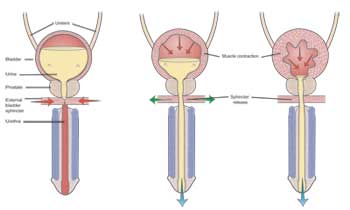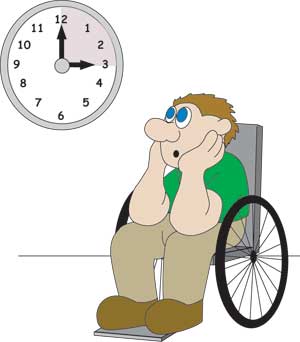Q: What is meant by balanced bladder technique?
A: The balanced bladder technique is not used by very many persons with spinal cord injury.
The basic principle is that the bladder is allowed to fill and every few hours the person uses an external stimulus to empty the bladder.
Q: How would I go about using the balanced bladder technique?
A: The bladder is allowed to store about 1 glass of urine.
About every 2-4 hours (depending somewhat on time of day and how much the individual drinks) the individual goes to the restroom and transfers onto the toilet.
Then an external stimulus is applied in the lower part of the body that causes the bladder to contract.
Q: What external stimulus would I use?
A: The most common approach is to tap vigorously over the bladder.
Other people find that pinching the skin or pulling on leg hair will cause a bladder contraction.
Whatever works that, is also safe, is fine.
After the bladder empties the person dries the area and returns to the wheelchair.
Most people who use this technique wear a diaper or pad between emptying times to lessen embarrassment should an accident occur.
Q: What are the advantages of the balanced bladder technique?
A: The main advantage of the balanced bladder technique is that infection rates are low because no catheter is used.
The rate of serious kidney infection is lees than 10% per year and the rate of bladder infection requiring treatment is about one per year.
Also, physical appearance is not an issue.
Q: Are there any problems with using the balanced bladder technique?
A: The biggest problem with this approach is that it doesn�t work well for many people.
Of 100 people who might try this, only about 20% succeed.
It takes a lot of motivation and luck to make it work.
Q: Why doesn�t this technique work for a lot of people?
A: The reason it doesn�t work very often has to do with accident rates and the frequency with which people need to go to the bathroom.
People who use this approach need to be prepared for a daytime accident at least once a week and nighttime accidents usually happen more frequently than that.
The nighttime accident rate is higher because many people with SCI make more urine in the night.
This is also when people are least able to be aware of their bladder needs.
Also, a hearty belly laugh, or at times the transfer to the toilet itself, can cause the bladder to empty.
Fluid intake must also be carefully controlled.
Finally, a person must be willing to take a bladder relaxant medication on a continual basis.





